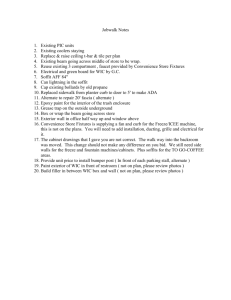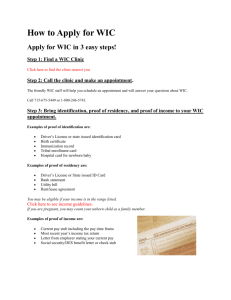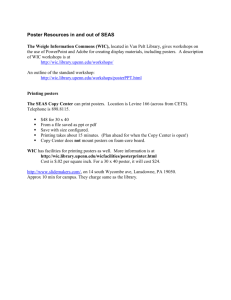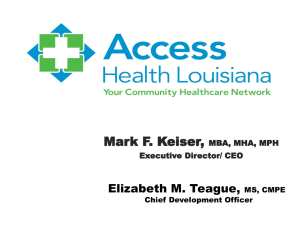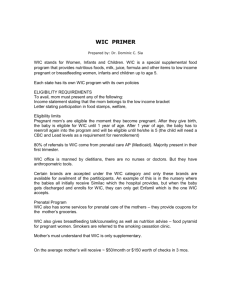TEACHING WITH WRITING
advertisement
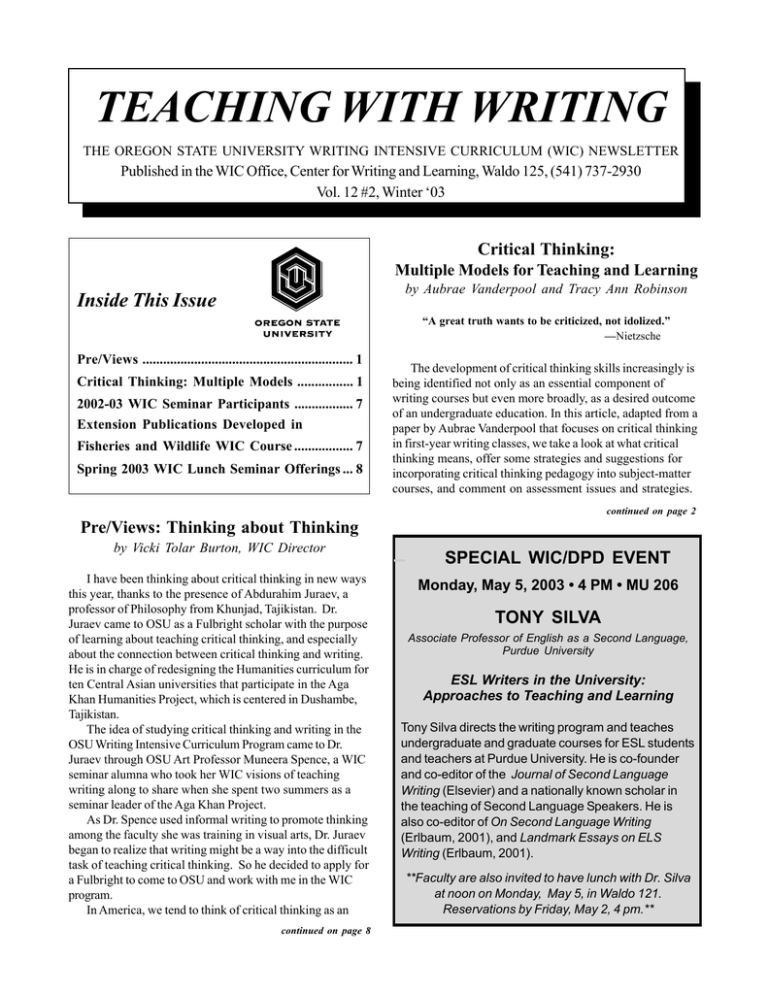
TEACHING WITH WRITING THE OREGON STATE UNIVERSITY WRITING INTENSIVE CURRICULUM (WIC) NEWSLETTER Published in the WIC Office, Center for Writing and Learning, Waldo 125, (541) 737-2930 Vol. 12 #2, Winter ‘03 Critical Thinking: Multiple Models for Teaching and Learning by Aubrae Vanderpool and Tracy Ann Robinson Inside This Issue “A great truth wants to be criticized, not idolized.” —Nietzsche Pre/Views ............................................................. 1 Critical Thinking: Multiple Models ................ 1 2002-03 WIC Seminar Participants ................. 7 Extension Publications Developed in Fisheries and Wildlife WIC Course ................. 7 Spring 2003 WIC Lunch Seminar Offerings ... 8 The development of critical thinking skills increasingly is being identified not only as an essential component of writing courses but even more broadly, as a desired outcome of an undergraduate education. In this article, adapted from a paper by Aubrae Vanderpool that focuses on critical thinking in first-year writing classes, we take a look at what critical thinking means, offer some strategies and suggestions for incorporating critical thinking pedagogy into subject-matter courses, and comment on assessment issues and strategies. continued on page 2 Pre/Views: Thinking about Thinking by Vicki Tolar Burton, WIC Director I have been thinking about critical thinking in new ways this year, thanks to the presence of Abdurahim Juraev, a professor of Philosophy from Khunjad, Tajikistan. Dr. Juraev came to OSU as a Fulbright scholar with the purpose of learning about teaching critical thinking, and especially about the connection between critical thinking and writing. He is in charge of redesigning the Humanities curriculum for ten Central Asian universities that participate in the Aga Khan Humanities Project, which is centered in Dushambe, Tajikistan. The idea of studying critical thinking and writing in the OSU Writing Intensive Curriculum Program came to Dr. Juraev through OSU Art Professor Muneera Spence, a WIC seminar alumna who took her WIC visions of teaching writing along to share when she spent two summers as a seminar leader of the Aga Khan Project. As Dr. Spence used informal writing to promote thinking among the faculty she was training in visual arts, Dr. Juraev began to realize that writing might be a way into the difficult task of teaching critical thinking. So he decided to apply for a Fulbright to come to OSU and work with me in the WIC program. In America, we tend to think of critical thinking as an continued on page 8 SPECIAL WIC/DPD EVENT Monday, May 5, 2003 • 4 PM • MU 206 TONY SILVA Associate Professor of English as a Second Language, Purdue University ESL Writers in the University: Approaches to Teaching and Learning Tony Silva directs the writing program and teaches undergraduate and graduate courses for ESL students and teachers at Purdue University. He is co-founder and co-editor of the Journal of Second Language Writing (Elsevier) and a nationally known scholar in the teaching of Second Language Speakers. He is also co-editor of On Second Language Writing (Erlbaum, 2001), and Landmark Essays on ELS Writing (Erlbaum, 2001). **Faculty are also invited to have lunch with Dr. Silva at noon on Monday, May 5, in Waldo 121. Reservations by Friday, May 2, 4 pm.** 2 TEACHING WITH WRITING--Vol. 12, #2, Winter ‘03 Critical Thinking—continued from page 1 Critical Thinking Defined…Or Not… For some critical thinking has a lot to do with understanding one’s own perspective and those of others. Another model [of critical thinking] is dialectic, an idea or work is critiqued in a way that produces a counter-perspective and ultimately leads to a synthesis. For some critical thinking evokes a synthetic or inductive model based on testing evidence and making arguments. The exercise of reflective judgment is also a form of critical thinking. (“Critical Thinking and Broad Knowledge”) While widely accepted as an educational imperative, critical thinking, as the above statement (exerpted from meeting notes for a Critical Thinking dialogue group at Western Washington University) indicates, is quite variously conceived and described. Numerous additional definitions and descriptions of critical thinking are available through the Longview Community College (Lee’s Summit, MO) Critical Thinking Across the Curriculum Project web site—see <http://www.kcmetro.cc.mo.us/longview/ctac/ definitions.htm>. Clearly, however, how an institution or department defines this intellectual practice will influencewhere in the curriculum critical thinking is taught, how it is taught, and, equally importantly, how it is assessed. For those in the process of formulating a working definition, familiarity with the following widely utilized models may serve as a helpful starting point. Bloom’s Taxonomy According to Benjamin Bloom’s Taxonomy of Educational Objectives (1956)—a cross-disciplinary model for developing higher-order thinking in students—learning how to think critically involves the mastery of six increasingly complex cognitive skills: knowledge (i.e., possession of specific facts or pieces of information), comprehension, application, analysis, synthesis, and evaluation. See sidebar for details. Bloom’s Taxonomy conceives critical thinking mastery as a sequential process, that is, one cannot move to the next cognitive tier without successfully negotiating the previous level. (“Teaching Critical Thinking”). Thus, some view the taxonomy as “a set of microlevel skills which may be used in critical thinking but do not represent critical thinking” (French and Rhoder 195). Philosopher Richard Paul objects to the taxonomy’s product-oriented conceptualization of thinking as a “one-way hierarchy” as opposed to thinking being a process that involves the recursive use of interrelated skills (French and Rhoder 195). Nonetheless, Bloom’s Taxonomy has been and continues to be an influential model for those developing critical thinking programs, as its inclusion in the Dartmouth College Composition Center’s critical thinking web page attests (Gocsik). BLOOM’S CATEGORIES IN THE COGNITIVE DOMAIN (with outcome-illustrating verbs) Knowledge: the remembering (recalling) of appropriate, previously learned terminology/specific facts/ways and means of dealing with specifics (conventions, trends and sequences, classifications and categories, criteria, methodology)/universals and abstractions in a field (principles and generalizations, theories and structures). defines; describes; enumerates; identifies; labels; lists; matches; names; reads; records; reproduces; selects; states; views. Comprehension: Grasping (understanding) the meaning of informational materials. classifies; cites; converts; describes; discusses; estimates; explains; generalizes; gives examples; makes sense out of; paraphrases; restates (in own words); summarizes; traces; understands. Application: The use of previously learned information in new and concrete situations to solve problems that have single or best answers. acts; administers; articulates; assesses; charts; collects; computes; constructs; contributes; controls; determines; develops; discovers; establishes; extends; implements; includes; informs; instructs; operationalizes; participates; predicts; prepares; preserves; produces; projects; provides; relates; reports; shows; solves; teaches; transfers; uses; utilizes. Analysis: The breaking down of informational materials into their component parts, examining (and trying to understand the organizational structure of) such information to develop divergent conclusions by identifying motives or causes, making inferences, and/or finding evidence to support generalizations. breaks down; correlates; diagrams; differentiates; discriminates; distinguishes; focuses; illustrates; infers; limits; outlines; points out; prioritizes; recognizes; separates; subdivides. Synthesis: Creatively or divergently applying prior knowledge and skills to produce a new or original whole. adapts; anticipates; categorizes; collaborates; combines; communicates; compares; compiles; composes; contrasts; creates; designs; devises; expresses; facilitates; formulates; generates; incorporates; individualizes; initiates; integrates; intervenes; models; modifies; negotiates; plans; progresses; rearranges; reconstructs; reinforces; reorganizes; revises; structures; substitutes; validates. Beyer’s evaluative thinking model Evaluation: Judging the value of material based on personal values/opinions, resulting in an end product, with a given purpose, without real right or wrong answers. appraises; compares & contrasts; concludes; criticizes; critiques; decides; defends; interprets; judges; justifies; reframes; supports. Barry Beyer, a prominent contemporary thinking skills theorist and teacher, interprets critical thinking as a more SOURCE: <http://faculty.washington.edu/krumme/ guides/bloom.html> Vol. 12, #2, Winter ‘03--TEACHING WITH WRITING 3 specifically evaluative activity than Bloom’s Taxonomy would imply: Critical thinking is not making decisions or solving problems. It is not the same as reflective thinking, creative thinking, or conceptualizing. Each of these other types of thinking serves a specific purpose. We make decisions in order to choose among alternatives. We solve problems when we encounter an obstacle to a preferred condition. We engage in creative or conceptual thinking to invent or improve things. Critical thinking serves a purpose quite different from these other types of thinking. (Beyer 1995, 8) For Beyer, the crux of critical thinking is criteria: “The word critical in critical thinking comes from the Greek word for criterion, kriterion, which means a benchmark for judging” (Beyer 1995, 8-9). Thus, critical (or, to use Beyer’s preferred term, evaluative) thinking provides the means to assess the “accuracy, authenticity, plausibility, or sufficiency of claims” (Beyer 1995, 10). Beyer asserts that critical thinking involves 10 cognitive operations, which can be employed in any sequence or combination as needed for the thinking task at hand: 1. Distinguishing between verifiable facts and value claims 2. Distinguishing relevant from irrelevant information, claims, or reasons 3. Determining the factual accuracy of a statement 4. Determining the credibility of a source 5. Identifying ambiguous claims or arguments 6. Identifying unstated assumptions 7. Detecting bias 8. Recognizing logical fallacies 9. Recognizing logical inconsistencies in a line of reasoning 10. Determining the strength of an argument or claim (Beyer 1988, 57) Further, Beyer argues that successful critical thinking requires “complex and often simultaneous interaction” of the following six elements: Dispositions. Critical thinkers develop habits of mind that “guide and sustain critical thinking”, including skepticism, fairmindedness, openmindedness, respect for evidence and reasoning, respect for clarity and precision, ability to consider different points of view, and a willingness to alter one’s position when reason and evidence call for such a shift. Criteria. Critical thinkers know about and have the ability to construct appropriate benchmarks for judging the issue at hand. Argument—defined as “a proposition with its supporting evidence and reasoning.” Critical thinkers are skillful at constructing, identifying, and evaluating the strength of arguments. Reasoning—the “cement that holds an argument together.” Critical thinkers determine the strength and validity of a conclusion by examining the soundness of the inductive or deductive process through which the conclusion was reached. Point of View. Critical thinkers are aware of their own point of view and capable of examining other points of view in order to better evaluate an issue. Procedures for applying criteria and judging. Critical thinkers have a repertoire of strategies appropriate to the subject matter and type of judgment to be made (Beyer 1995, 10-20) In other words, Critical thinkers habitually question the authenticity of anything that confronts them to ascertain exactly the extent to which it is an authentic instance of what it purports to be. In addition, they make judgments based on certain standards or other measures that serve as criteria for plausibility and truthfulness. And they pay special attention to the reasons and reasoning that undergird conclusions and claims.” (Beyer 1995, 22) Critical thinking as a divergent process While Beyer depicts critical thinking as a “convergent,” narrowing process, others prefer to view it as a divergent, expanding, exploratory practice (French and Rhoder, 184-85) —a way to open up new solutions as well as evaluate those that have already been identified. For example, consider this statement from Peter Taylor of the UMass/Boston Graduate College of Education’s Critical and Creative Thinking Program. (In February, 2001, Taylor led a critical thinking workshop at OSU, sponsored jointly by the College of Liberal Arts’ Center for Excellence in Teaching, Learning, and Research, the Center for Water and Environmental Sustainability, and the Office of Academic Affairs; and organized by Anita Helle [English] and Denise Lach [CWest].) My sense of critical thinking […] depends on inquiry being informed by a strong sense of how things could be otherwise. I want students to see that they understand things better when they have placed established facts, theories, and practices in tension with alternatives. Critical thinking at this level should not depend on students rejecting conventional accounts, but they do have to move through uncertainty. Their knowledge is, at least for a time, destabilized; what has been established cannot be taken for granted. This view suggests a much closer connection between critical and creative thinking than Beyer, for instance, would subscribe to. However, many of the concerns that underlie the current interest in furthering college students’critical thinking skills recognize and affirm this connection. Teaching Considerations and Strategies One of the ongoing debates surrounding the inclusion of critical thinking instruction in undergraduate curricula is whether such instruction should be delivered via separate critical thinking courses or integrated into existing subjectmatter courses. Today, the latter approach seems generally preferred; according to French and Rhoder, “the push for teaching critical thinking in content areas is strong” (198). 4 TEACHING WITH WRITING--Vol. 12, #2, Winter ‘03 This push may derive from a number of factors, including escalating concerns throughout academe about college students’ growing inability (and unwillingness) to truly engage course content; the Information Age-related conceptual shift in which teaching no longer is equated with covering a broad range of material but rather with facilitating indepth examinations of selected issues and ideas; and the recognition that “critical thinking is an essential precondition of content knowledge” (Paul in French and Rhoder 199). Scriven and Paul assert that critical thinking “is based on universal intellectual values that transcend subject matter divisions.” However, by foregrounding and problematizing conflicting information, perspectives, and beliefs related to specific course material, a critical-thinking-based pedagogy forces students and teachers to become aware of their own thinking about the material, which enhances the learning of that material even as it provides a practical context for cognitive skills development. But whether we teach critical thinking separately or as part of as subject matter courses, which cognitive tasks we associate with this skill, and whether we view their mastery as a sequential or recursive process, the following pedagogical considerations, forwarded by Peter Taylor, merit our attention: Critical thinking is a personal journey into unknown areas or where one sees known areas in new light. We (teachers as well as students) need to clear mental space so that thoughts about an issue in question can emerge that had been below the surface of our attention. As teachers, we need to recognize the diversity of students’ perspectives, styles of learning, dispositions for critical thinking, comfort level with exploration and activities before explanation, and other mental, emotional, situational, and relational factors that affect their capacity to “re-see.” Listening well helps students tease out alternative views; being listened to helps students access their innate knowledge. Unaddressed fears, of both students and teachers, impede the development and application of critical thinking skills. B. Lehman and D. Hayes propose the following strategies for promoting critical thinking in the classroom: Help students recognize what they already know about a topic. [For suggestions, see next section.] Help students learn to recognize their biases and keep an open mind about the topic. Have students list and share opinions on the subject, but postpone evaluation until more information is gathered. Formulate open-ended questions to help students analyze, synthesize, and evaluate the topic. Guide students in finding and using diverse sources to explain and support their ideas. Have students check the validity of sources and qualifications of authors. Help students see there is no single, final authority. By reading several sources on the same topic, students will discover that information is often conflicting and contradictory. Help students develop criteria for evaluation. As students learn to support their opinions with logical thinking and comparison of sources, they [develop] critical thinking skills. (Smith 350) Example: “Conflicting accounts” assignment Here’s an assignment that utilizes many of the strategies listed above. Most specifically, it helps students learn how to form conclusions about a contradictory issue in the absence of any “single final authority.” In teaching argument in a first-year composition course at Northern Virginia Community College, Ruth Stewart originally used a first-yearcomposition-textbook “opposing viewpoints assignment” that required students to conduct their own research (Stewart 163). What she noticed over time, however, was that “most of the papers submitted consisted of trite if energetic proclamations about abortion, gun control, capital punishment, and the like, interspersed with poorly integrated, often only marginally relevant quotations from students’ research” (163). Recognizing that most students had not been successful in developing “a realistic idea of the depth, breadth, and complexity of evidence necessary to make an informed judgment about [their] subject” (163), Stewart crafted a new assignment in which she omitted the research component and instead supplied her students with the required information sources. These included excerpts from firsthand accounts, government documents, newspaper articles, and pieces of correspondence that provided different perspectives on the 1763 Conestoga Massacre in Pennsylvania. Here, Stewart explains her reasons for this move: Ultimately, to ensure that students had ample strong evidence for both sides of a controversial issue, I decided to give it to them. I have had greater success postponing research assignments until after students have acquired a sense of the amount and strength of evidence that their research should produce. Not only does providing students with evidence prevent them from consciously or unconsciously passing up strong opposing arguments, it also requires that they raise their analytical skills to the level that the evidence demands. And once students experience the excitement inherent in higher-order thinking, they are motivated in subsequent assignments to do research that will produce that same excitement of discovery. (165) Stewart’s new assignment—to analyze the conflicting accounts in order to make an assertion about the legality of the massacre—highlights the importance of evaluating sources, making evidence-based claims, and emphasizing the role of interpretation when making assertions. Stewart finds this “conflicting accounts” assignment much more successful than the former “opposing viewpoints” assignment at helping students develop “a sophisticated understanding of the nature of knowledge…as no longer simple and absolute, but complex and tentative” (169). An important factor in the assignment’s success is that it deals with a situation for which no detailed historical interpretation exists; thus the students have no other choice than to form and defend their own conclusions about the controversy. See the sidebar for Stewart’s suggestions on developing similar assignments. Vol. 12, #2, Winter ‘03--TEACHING WITH WRITING 5 GUIDELINES FOR DEVELOPING “CONFLICTING ACCOUNTS” ASSIGNMENTS Topics need not be historical, as long as they have not been the subject of in-depth, widely available modern interpretation. Possibilities are lesser known court decisions (students could frame an appeal or rejection of an appeal) and issues involving cultural perspectives outside of most students’ experience, such as the debate between Native Americans and anthropologists over the ownership of a nine-thousand-year-old human fossil. Allow yourself ample time to locate sources. You need to give students enough material both to enable responsible analysis and to replicate the variety of sources encountered in thorough research. Include weak or problematic sources, and explain to students that handling such evidence is just one more facet of strong analysis. If cost or copyright laws make mass duplication of sources impractical, place them on reserve in the library or scan them onto your web page. Assign a single, specific goal for the analysis. To generate constructive debate, all students should analyze the assigned evidence for the same purpose and audience, and according to agreedupon criteria. Require a written evaluation of the strengths and weaknesses of the evidence. I tell students to pretend they are attorneys selecting evidence to use in the courtroom. Why should this item be presented first, that item last? How might an opposing attorney try to weaken your evidence, and how can this attack be refuted? Allow ample class time for students to discuss the topic both as a class and in groups. Encountering their classmates’ views is often what makes students realize that “the truth” is neither obvious nor absolute. (pp. 169-70 in Stewart, Ruth, “Teaching Critical Thinking in First-Year Composition: Sometimes More Is More,” Teaching English at the Two-Year College, December 2001: 162-171.) The Writing–Critical Thinking Connection For centuries, the rhetorical assumption about language was that “one first finds knowledge and then puts it into words” (Bizzell, Herzberg, and Reynolds 1)—in other words, thinking always precedes writing or speaking. Today, however, we recognize that “knowledge is actually created by words” (Bizzell, Herzberg, and Reynolds 1) and that writing and thinking are recursive, interdependent processes that promote and enhance one another. James Sheridan points out that “the act of generating written discourse is not merely a result of critical thinking but also a stimulus to new thinking and new discoveries” (52). This claim echoes Linda Flower’s assertion that “writing is a generative act—a process of not just ‘expressing’ but ‘making’meaning” (193-94). The fact is that “when students write, they cannot remain passive players in the learning game” (Gocsik). As Peter Elbow suggests, “writing helps us achieve the perennially difficult task of standing outside our own thinking” (27). Hence, the concept of “writing to learn,” which has become so integral to Writing Across the Curriculum courses and programs. Using writing to uncover knowledge As well as using writing to reinforce and integrate new information, writing can be a way of discovering existing knowledge. Many critical thinking experts advocate beginning any new learning unit by identifying what students already know (but often don’t know they know) about the topic. This strategy promotes critical thinking and active learning by allowing students to “establish a context for new information and share ideas with others” (Smith 350). Two writing strategies that can assist in this discovery process are freewriting and the “write-and-pass” exercise: Freewriting. Describing freewriting as an activity that “helps students break the writing-is-grammar chain [, which] stultifies the freedom and risk-taking necessary for innovative critical thinking” (53), James Sheridan suggests the process has only two requirements: (1) “You cannot stop writing during the 10-minute exercise.” (2) “You are forbidden to think. [. . .] Write whatever comes into your right (or left) hand. You must keep on writing. Even if you say ‘I don’t know what to write,’ write that. You cannot scratch your head. You cannot gaze pensively at the ceiling. Just write. You are not responsible for what you say; your hand is doing it all. Say anything. Say ‘This is the worst exercise I ever heard of and I can’t believe they’re paying this guy good bucks to have us do it.’ Yell, scream, shout, kick (in written words). Say anything, but keep writing” (52) With unfocused freewriting, students write about whatever they want. With focused, or directed, freewriting, students are given a topic or question to write on. Write-and-pass. Another informal writing assignment that helps students discover what they already know is to ask them to spend a few minutes writing everything they can think of about a given topic or question (for example, “What is critical thinking?”). After several minutes, students pass what they’ve written to the person next to them, and that person reads and expands on the original response. The process is repeated a few more times; generally, with each pass, adding new information becomes more challenging.. The exercise provides a way both for students to focus their thoughts on a particular topic and to benefit from one another’s stores of knowledge. Assessing Critical Thinking: Current Models [A]n informed choice of an approach to assessing critical thinking can be made only after faculty have [asked and 6 TEACHING WITH WRITING--Vol. 12, #2, Winter ‘03 answered] these questions: What do we think critical thinking is? How do the critical thinking skills, processes, and strategies work together, and what aspects or combinations of them do we wish to assess? What are our students like? What are their motivations [and] environments? What are our assumptions relative to the knowledge and abilities that students need prior to engaging in college-level critical thinking? (Carpenter and Doig 34-35) Carpenter and Doig’s observation comes from a 1988 review of assessment instruments developed for specific critical thinking courses and programs. Alternatively, the rubric developed in 2002 by Washington State University’s Critical Thinking Project can be used in subject-matter courses across the curriculum that focus on critical thinking. This rubric includes the following criteria for student writing: 1. Identifies and summarizes the problem/question at issue. 2. Identifies and presents the student’s own perspective and position as it is important to the analysis of the issue. 3. Identifies and considers other salient perspectives and positions that are important to the analysis of the issue. 4. Identifies and assesses the key assumptions. 5. Identifies and assesses the quality of supporting data/ evidence and provides additional data/evidence related to the issue. 6. Identifies and considers the influence of the context (e.g. cultural/social, scientific, educational, economic, technological, ethical, political, personal, and so on) on the issue. 7. Identifies and assesses conclusions, implications, and consequences. “Critical Thinking Rubric” Each item in the rubric includes a description of what would be considered “scant” vs “substantially developed” coverage of that item. The Washington State Critical Thinking Project website also includes links to specific assignments, developed by WSU faculty from a number of different disciplines, that engage the rubric. A Final Note In this article, we have focused on what Kerry S. Walters describes as the “logicistic” model of critical thinking—that is (according to Walters) “the unwarranted assumption that good thinking is reducible to logical thinking” (1). In ReThinking Reason: New Perspectives in Critical Thinking, Walters explores an alternative model being forwarded by an emerging “second-wave” of critical thinking research and pedagogy. Second-wave advocates argue that while “logical skills are essential functions of good thinking, […] so are non-analytic ones such as imagination and intuition, and the good thinker knows how to utilize both types” (2). This reconception of critical thinking is grounded in current scholarship in the fields of philosophy, psychology, education, feminist theory, and critical pedagogy; Walters’s book serves as an introduction to and dialogue among some of the proponents and practitioners of this alternative. While beyond the scope of this article, the second-wave perspective on critical thinking deserves our serious attention and consideration as well. Works Cited Beyer, Barry K. Critical Thinking. Bloomington, IN: Phi Delta Kappa Educational Foundation, 1995. ________. Developing a Thinking Skills Program. Boston: Allyn and Bacon, 1988. Bizzell, Patricia, Bruce Hertzberg, and Nedra Reynolds. The Bedford Bibliography for Teachers of Writing. 5th Ed. Boston: Bedford/St. Martin’s, 2000. Carpenter, C. Blaine, and James C. Doig. “Assessing Critical Thinking Across the Curriculum.” Assessing Student’s Learning 34 (Summer 1988): 33-46. “Critical Thinking and Broad Knowledge Meeting Notes.” 2 Nov. 2001. Center for Instructional Innovation, Western Washington University. 4 March 2003. <http://pandora.cii.wwu.edu/gened/ dialogue/critical_notes_nov.htm> “Critical Thinking Web Site.” 1996. Critical Thinking Across the Curriculum Project, Longview Community College. 4 March 2003. <http://www.kcmetro.cc.mo.us/longview/ctac/index.htm> “The Critical Thinking Rubric.” 2002. Washington State University Critical Thinking Project. 27 Feb. 2003. <http:// wsuctproject.wsu.edu/ctr.htm> Elbow, Peter. “Teaching Two Kinds of Thinking by Teaching Writing.” Re-Thinking Reason: New Perspectives in Critical Thinking. Ed. Kerry S. Walters. Albany: SUNY Press, 1994. 2531. Flower, Linda. “Taking Thought: The Role of Conscious Processing in the Making of Meaning.” Thinking, Reasoning, and Writing. Ed. Elaine P. Maimon, Barbara F. Nodine, and Finbarr W. O’Connor. NY: Longman, 1989. 185-212. French, Joyce N. and Carol Rhoder. Teaching Thinking Skills: Theory and Practice. NY: Garland, 1992. Gocsik, Karen. “Teaching Critical Thinking.” 1997. Dartmouth College Composition Center. 27 Feb. 2003. <http:// www.dartmouth.edu/~compose/faculty/pedagogies/ thinking.html> Scriven, Micheal and Richard Paul. “Defining Critical Thinking.” Draft Statement for the National Council for Excellence in Critical Thinking. Foundation for Critical Thinking. 27 Feb. 2003. <http://www.criticalthinking.org/University/univclass/ Defining.html> Sheridan, James J. “Skipping on the Brink of the Abyss: Teaching Thinking Through Writing.” Critical Thinking: Educational Imperative. Ed. Cynthia A. Barnes. New Directions for Community Colleges, No. 77. San Francisco: Jossey-Bass, 1992. 51-61. Smith, Carl B. “Two Approaches to Critical Thinking.” The Reading Teacher 4.4 (Dec. 1990): 350-51. Stewart, Ruth. “Teaching Critical Thinking in First-Year Composition: Sometimes More Is More.” Teaching English at the TwoYear College 29 (Dec. 2001): 162-171. Taylor, Peter. “We Know More Than We Are, At First, Prepared To Acknowledge: Journeying to Develop Critical Thinking.” 12 March 2003 <http://www.faculty.umb.edu/peter_taylor/ journey.html> Walters, Kerry S. Re-Thinking Reason: New Perspectives in Critical Thinking. Albany: SUNY Press, 1994. Vol. 12, #2, Winter ‘03--TEACHING WITH WRITING 7 2002-03 WIC Seminar Participants Twenty-eight OSU faculty from 20 departments and programs across three campuses completed this year’s introductory Writing Intensive Curriculum seminars, offered during fall and winter terms. In addition, visiting Fulbright Scholar Abdurahim Juraev offered a valuable international perspective this year. Participants in the five-week seminars included: Fall 2002: Dena Garner, Exercise and Sport Science; Laura Gow, Eastern Oregon Agricultural Research Center; Kathy Greaves, HDFS; Abdurahim Juraev, WIC Courtesy Scholar; Joseph Orosco, Philosophy; Paul Paulson, Computer Science; Jim Peterson, Crop and Soil Science; William Petty, English/E-Campus; Micheal Qian, Food Science and Technology; Steve Sharrow, Rangeland Resources; Dan Smith, Food Science and Technology; John Tanaka, Eastern Oregon Agricultural Research Center; Kal Toth, Computer Science; Alex Yokochi, Chemistry. Winter 2003: Sheryl Bird, Public Health; Kevin Boston, Forestry Engineering; Deborah Padgett Coehlo, HDFS (Bend); Candace Croney, Animal Science; Audrey Meier DeKam, English; Ron Dowd, HDFS (Bend); Marla Hacker, Business (Bend); Jessica Howe, Horticulture; Henri Jansen, Physics; Kate MacTavish, HDFS; Patricia Muir, Botany and Plant Pathology; Lea Murphy, Mathematics; Peggy Pedersen, Public Health; Carol Tremblay, Economics; Jun Xing, DPD Program. About Teaching With Writing Editor: Vicki Tolar Burton Assistant Editor: Tracy Ann Robinson Teaching With Writing is the newsletter of the Oregon State University Writing Intensive Curriculum Program. As part of the Baccalaureate Core, all OSU students are required to take an upper division writing intensive course in their major. The content of the WIC courses ranges from radiation safety (for Nuclear Engineering majors) to golf courses design (a Horticulture option). While subject matter differs by department, all WIC courses share certain commonalities defined by the Faculty Senate: • Informal, ungraded or minimally graded writing is used as a mode of learning the content material. • Students are introduced to conventions and practices of writing in their discipline and use of borrowed information. • Students complete at least 5000 words of writing, of which at least 2000 words are in polished, formal assignments. • Students are guided through the whole writing process, receive feedback on drafts, and have opportunities to revise. For complete information on WIC guidelines, contact Vicki Tolar Burton by email at vicki.tolarburton@oregonstate.edu, visit the WIC web site at <<http://wic.oregonstate.edu>>, or consult the OSU Curricular Procedures Handbook. Extension Publications Developed in Fisheries and Wildlife WIC Course Oregonians searching this spring for information on wildlife gardening will reap the benefits of student writing in Dan Edge’s Fisheries and Wildlife Problem Analysis and Resolution WIC course. In one of these project-based courses, students developed educational materials for the OSU Extension Wildlife Program’s urban wildlife habitat program. These materials are used to support the department’s extension programming; they serve as presentations and handouts on landscaping urban yards for wildlife. They have also been added to the 4-H Wildlife Stewards Project Handbook and have been used by teachers and volunteers to create wildlife habitat on K-12 schools grounds. Last year, eight were published by the OSU Extension Service as extension circulars. This attractively designed “Wildlife Garden Series” is also available (in PDF format) at <http://fw.oregonstate.edu/ extension/wildlife/html/publications.htm>. Edge experienced some challenges in trying to convert papers by a group of seniors into publications. Even though the papers went through multiple revisions (through student peer-reviews, outside content reviews, and two instructor reviews), they were still not ready to be submitted to the Extension Service by the end of the term. And despite the instructor’s stressing the importance of getting a publication on their resumes, none of the student writers were interested in doing that additional work after graduation. The task of publication follow through thus fell to recently hired Extension Wildlife Instructor Nancy Allen, which is why she is listed as co-author on each of the publications. WILDLIFE GARDEN SERIES Attract Hummingbirds to Your Garden EC 1541 Attract Reptiles and Amphibians to your Yard EC 1542 Create a Butterfly Garden EC 1549 Create a Garden Pond for Wildlife EC 1548 The Wildlife Garden: Feed Wild Birds EC 1554 The Wildlife Garden: Create Roosts for Bats in Your Yard EC 1555 The Wildlife Garden: Build Nest Boxes for Wild Birds EC 1556 The Wildlife Garden: Reduce Deer Damage in Your Yard EC 1557 8 TEACHING WITH WRITING--Vol. 12, #2, Winter ‘03 WIC Eating-to-Learn Lunch Seminar Schedule, Spring 2003 All seminars are held 12-1 pm in the WIC/CWL Conference Room, 121 Waldo. Pizza and beverages provided. Please email your reservation (to vicki.tolarburton@oregonstate.edu) by noon on the day preceding the seminar. Wednesday, April 9th: Critical Thinking Across the Curriculum, Part I. Critical Thinking and Writing. A discussion of several models of critical thinking (see article, page 1). Wednesday, April 16th: Critical Thinking Across the Curriculum, Part II. Critical Thinking in Post-Soviet Higher Ed: A Conversation with Dr. Abdurahim Juraev, Fulbright Scholar from Tajikistan. Wednesday, April 23rd: Speaking Across the Curriculum, Part I. Preparing Students for Making Effective Oral Presentations. Discussion led by Dr. Robert Iltis, Speech Communication. Wednesday, April 30th: Speaking Across the Curriculum, Part II. Panel discussion with WIC faculty who include an oral communication focus in their WIC classes. Monday, May 5: Lunch with Tony Silva, editor of Journal of Second Language Writing Wednesday, May 14: Twenty Most Common Errors in Writing: New Tools for Teaching and Learning Grammar in Subject-Matter Courses. All faculty are welcome—come and bring a colleague Pre/Views—continued from page 1 intellectual component of a well-rounded education. In Tajikistan, according to Dr. Juraev, critical thinking is essential for the survival of his country in the Post-Soviet era. The curricular innovations he is conceiving in Corvallis will help his and other Central Asian universities make the transition from a Soviet pedagogical system of received truths to a more open university system that prepares students to think critically about their lives, their country, and their world. Over the past few months, as my Tajik colleague eagerly engaged the implications of teaching writing as a mode of learning, I began to give more thought to what a nebulous concept “critical thinking” can be at our own university. All of our Baccalaureate Core courses are supposed to include critical thinking among learning outcomes, but professors are often at a loss as to what, exactly, critical thinking is. Is there one definition of critical thinking that fits all courses? If critical thinking skills vary from discipline to discipline, are there also commonalities across the curriculum? How can critical thinking be taught? In this issue of Teaching With Writing, an article by two English graduate students, Aubrae Vanderpool and Tracy Ann Robinson, seeks to open a conversation about critical thinking by presenting a variety of models that are in play in academia today. If you find this article helpful, puzzling, or infuriating, please join us for the first two WIC Eating-to-Learn Seminars of spring term on April 9 and 16. On April 9, we will discuss how the various models of critical thinking relate to our teaching, in WIC but also in other courses. On April 16, Dr. Abdurahim Juraev will share his ideas about the importance of critical thinking in higher education for the PostSoviet era in Central Asia. His academic specialization is Cultural Transformation, so he will be sharing both theoretical and practical reflections on the subject. Please join us to learn how OSU will help with change in a country thousands of miles from Corvallis. A second pair of Eating-to-Learn seminars, on April 23 and 30, will engage the topic of Speaking Across the Curriculum. More and more, we hear from stakeholders that our students must not only be effective writers but they must also be able to present their knowledge and ideas orally. On April 23, Dr. Robert Iltis, Professor of Speech Communication, will lead a discussion on how to prepare students for making effective oral presentations. What is the writingspeaking connection? On April 30, we will hear from WIC teachers who are already including oral presentations in their courses. The full WIC Lunch Seminar schedule for spring 2003 appears at the top of this page. Please join us, and bring your colleagues.
